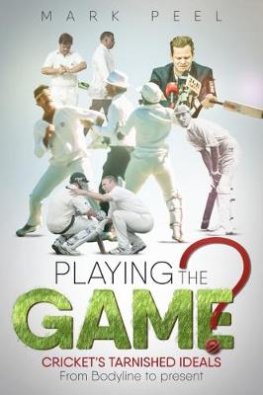Playing The Game
Martin Chandler |Published: 2018
Pages: 288
Author: Peel, Mark
Publisher: Pitch Publishing
Rating: 3.5 stars

Like any sport cricket brings out tribal instincts amongst not only those who play, but also those who follow. At the highest level the combatants are also dependent on their game for their living, and that means they need to succeed. There is inevitably therefore a tension between players and that sometimes elusive concept, the Spirit of Cricket. In the final chapter of Playing The Game Peel provides as good a definition of that as I have seen, albeit one that is still not entirely satisfactory.
The sort of issues that Mark Peel examines in this book, his second of the year after a lengthy hiatus, have existed since the game’s earliest days. There are a few mentions of WG Grace, but none of the likes of Frederick Beauclerk and, realistically, Peel’s account begins with the famous Bodyline series of 1932/33.
There are books aplenty that deal with every aspect of that controversial tour and, as is the case throughout the book, Peel does not dwell on the play itself in any significant way and concentrates on his brief. Inevitably he can add nothing new in terms of evidence, but illustrates very well the future of unrelenting pace bowling, and contributes some interesting thoughts on the mind set of Bodyline’s main target, Sir Donald Bradman when, a decade and a half later, he had the services of Ray Lindwall and Keith Miller to deploy against Len Hutton and Denis Compton. A few years later of course Hutton in turn, by then England captain, had a shock bowler himself in Frank Tyson, and so the story goes on through the decades.
A major theme in Playing The Game is sledging and player behaviour generally, and others are throwing and ball tampering. It is clear from the list of sources at the back of the book how widely and thoroughly it has been researched. Testament to the quality of the writing is that on more than one occasion I found myself wondering whether what I had read was correct, and each time on checking it proved to be the case that it was.
In some ways there is little that is new in a book like this, but it is rare indeed that the related issues have all been looked at together and for that reason alone the mere fact that a reader has most of the books and is already well acquainted with the content should not discourage the purchase of Playing The Game. Peel marshalls the facts in exemplary fashion and sets them out in an essentially neutral way. Only occasionally does his prose give glimpses of his personal opinion, one example being the authorities’ “now you see it, now you don’t” actions over the forfeited Oval Test of 2006.
One striking feature of the book is how much of its content has arisen since that watershed date of 2000 when the MCC embraced the Spirit of Cricket. The increase in the amount of international cricket played in recent years does make it difficult to keep up with everything that happens and one of the great benefits of Playing The Game to this reviewer was finally getting to grips with exactly what the ‘Monkeygate’ incident that involved Harbhajan Singh and Andrew Symonds in 2008 was all about. Neither man has ever figured amongst my favourite players, but the stock of both has risen in my estimation as a result of Peel’s explanation, albeit for somewhat different reasons. I hadn’t really taken it on board before that Symonds was primarily the sinned against rather than the sinner, and I was also surprised, having listened to him all summer in the Sky commentary box, that back in 2008 Harbhajan’s English was virtually non-existent.
Also of much interest, for the contradictions in the way different incidents have been dealt with if nothing else, are the chapters on ball tampering. The book was well timed in that it was able to deal fully with ‘sandpapergate’, and indeed all the other incidents that arose out of the ill-starred series between Australia and South Africa earlier this year. A tearful Steve Smith is on the dust jacket of the book, and a couple of well chosen photographs appear inside as well. That particular episode is summarised in the same comprehensive way in which so many similar incidents are looked at, and the older ones are often illustrated by quotes from the great and the good gleaned from newspapers which, perhaps, some of those who made the comments would rather had not been republished. I must confess to, for some time, considering that what followed the Smith/Warner/Bancroft/Lehmann investigation had something of a hysterical overreaction about it. After reading Peel’s book I have had cause to review that opinion and, on reflection, I can now see what all the fuss was about.
Any book that successfully challenges its readers pre-conceived ideas is certainly doing something right and, with the festive season fast approaching, Playing The Game deserves to sell very well indeed.






Leave a comment